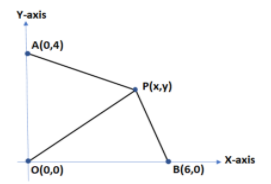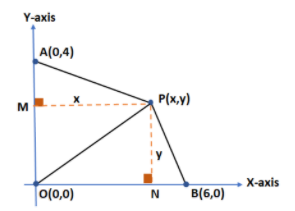
The coordinates of three points O, A, B are $\left( {0,0} \right)$, $\left( {0,4} \right)$and$\left( {6,0} \right)$ respectively, a point P moves so that area of triangle POA is always twice the area of triangle POB. Find the equation for both parts of locus of P.
A) $\left( {x - 3y} \right)\left( {x - 3y} \right) = 0$
B) $\left( {x + 3y} \right)\left( {x + 3y} \right) = 0$
C) $\left( {x - 3y} \right)\left( {x + 3y} \right) = 0$
D) None of these
Answer
561.6k+ views
Hint:
To solve this question let point P lies on $\left( {x,y} \right)$. Draw the triangle on the graph according to the question and then find the area of both the triangle i.e. \[\vartriangle POA\] and \[\vartriangle POB\] by the formula given below:
$ \Rightarrow A = \dfrac{1}{2} \times b \times h$, ………..(1)
Where A is the area of the triangle, b be the base of the triangle and h be the height of the triangle.
Now, equate the area of both the triangles as given in the question i.e.
$ \Rightarrow {A_1} = 2{A_2}$, where ${A_1}$ is the area of \[\vartriangle POA\] and ${A_2}$ is the area of \[\vartriangle POB\].
Complete step by step solution:
Let us see what is given to us? We are given with the coordinates of three points i.e. $O\left( {0,0} \right)$, $A\left( {0,4} \right)$and $B\left( {6,0} \right)$.
We have to find the equation of point P to both parts of the locus such that the area of \[\vartriangle POA\] is equal to twice the area of \[\vartriangle POB\].
$ \Rightarrow {A_1} = 2{A_2}$, ………..(2)
where ${A_1}$ is the area of \[\vartriangle POA\]and ${A_2}$ is the area of \[\vartriangle POB\].
First of let us assume Point P coordinates as $\left( {x,y} \right)$. After that draw the triangles as given in the question on graph. The graph is given as follow:

To find ${A_1}$, we draw a line perpendicular from point M at AO to meet at point P and To find ${A_2}$, we draw a line perpendicular from point N at BO to meet at point P as given in figure below:

To find area of \[\vartriangle POA\], find AO and PM by distance formula i.e.
\[ \Rightarrow AO = \sqrt {{{\left( {{x_2} - {x_1}} \right)}^2} + {{\left( {{y_2} - {y_1}} \right)}^2}} \]
By putting the values of their respective co-ordinates, we get,
\[ \Rightarrow AO = \sqrt {{{\left( {0 - 0} \right)}^2} + {{\left( {4 - 0} \right)}^2}} \]
By opening the bracket and solving it, we get,
\[ \Rightarrow AO = 4\] ………..(3)
Similarly,
\[ \Rightarrow PM = \sqrt {{{\left( {x - 0} \right)}^2} + {{\left( {y - y} \right)}^2}} \]
By opening the bracket and solving it, we get,
\[ \Rightarrow PM = x\] …………(4)
Hence, area of \[\vartriangle POA\]can be calculated from formula (1) as
$ \Rightarrow {A_1} = \dfrac{1}{2} \times AO \times PM$
Putting the value of AO and PM from (3) and (4), we get,
$ \Rightarrow {A_1} = \dfrac{1}{2} \times 4 \times x$
By solving it we get,
$ \Rightarrow {A_1} = 2x$ ……..(5)
To find area of \[\vartriangle POB\], find BO and PN by distance formula i.e.
\[ \Rightarrow BO = \sqrt {{{\left( {{x_2} - {x_1}} \right)}^2} + {{\left( {{y_2} - {y_1}} \right)}^2}} \]
By putting the values of their respective co-ordinates, we get,
\[ \Rightarrow BO = \sqrt {{{\left( {6 - 0} \right)}^2} + {{\left( {0 - 0} \right)}^2}} \]
By opening the bracket and solving it, we get,
\[ \Rightarrow BO = 6\] ………..(6)
Similarly,
\[ \Rightarrow PN = \sqrt {{{\left( {x - x} \right)}^2} + {{\left( {y - 0} \right)}^2}} \]
By opening the bracket and solving it, we get,
\[ \Rightarrow PN = y\] …………(7)
Hence, area of \[\vartriangle POA\]can be calculated from formula (1) as
$ \Rightarrow {A_2} = \dfrac{1}{2} \times BO \times PN$
Putting the value of BO and PN from (6) and (7), we get,
$ \Rightarrow {A_2} = \dfrac{1}{2} \times 6 \times y$
$ \Rightarrow {A_2} = 3y$ …………(8)
By putting the value of area from (5) and (8) in equation (2), we get,
\[ \Rightarrow 2x = 2\left( {3y} \right)\]
By opening the bracket, we get,
\[ \Rightarrow 2x = \pm 6y\]
By cancelling 6 with 2, we get,
$$ \Rightarrow x = \pm 3y$$
$$ \Rightarrow \left( {x + 3y} \right)\left( {x - 3y} \right)$$
Hence, option C is the required answer.
Note:
It is noted that we have taken two values i.e. one is positive and other is negative while comparing the areas. As it is not given that point P lies in the first quadrant so we consider both the conditions that P can be on the first quadrant or on the fourth quadrant.
If we are given the quadrant of P then we have to take respective signs.
Some students forget to draw the line perpendicularly and take the other side as height which is the wrong method.
To solve this question let point P lies on $\left( {x,y} \right)$. Draw the triangle on the graph according to the question and then find the area of both the triangle i.e. \[\vartriangle POA\] and \[\vartriangle POB\] by the formula given below:
$ \Rightarrow A = \dfrac{1}{2} \times b \times h$, ………..(1)
Where A is the area of the triangle, b be the base of the triangle and h be the height of the triangle.
Now, equate the area of both the triangles as given in the question i.e.
$ \Rightarrow {A_1} = 2{A_2}$, where ${A_1}$ is the area of \[\vartriangle POA\] and ${A_2}$ is the area of \[\vartriangle POB\].
Complete step by step solution:
Let us see what is given to us? We are given with the coordinates of three points i.e. $O\left( {0,0} \right)$, $A\left( {0,4} \right)$and $B\left( {6,0} \right)$.
We have to find the equation of point P to both parts of the locus such that the area of \[\vartriangle POA\] is equal to twice the area of \[\vartriangle POB\].
$ \Rightarrow {A_1} = 2{A_2}$, ………..(2)
where ${A_1}$ is the area of \[\vartriangle POA\]and ${A_2}$ is the area of \[\vartriangle POB\].
First of let us assume Point P coordinates as $\left( {x,y} \right)$. After that draw the triangles as given in the question on graph. The graph is given as follow:

To find ${A_1}$, we draw a line perpendicular from point M at AO to meet at point P and To find ${A_2}$, we draw a line perpendicular from point N at BO to meet at point P as given in figure below:

To find area of \[\vartriangle POA\], find AO and PM by distance formula i.e.
\[ \Rightarrow AO = \sqrt {{{\left( {{x_2} - {x_1}} \right)}^2} + {{\left( {{y_2} - {y_1}} \right)}^2}} \]
By putting the values of their respective co-ordinates, we get,
\[ \Rightarrow AO = \sqrt {{{\left( {0 - 0} \right)}^2} + {{\left( {4 - 0} \right)}^2}} \]
By opening the bracket and solving it, we get,
\[ \Rightarrow AO = 4\] ………..(3)
Similarly,
\[ \Rightarrow PM = \sqrt {{{\left( {x - 0} \right)}^2} + {{\left( {y - y} \right)}^2}} \]
By opening the bracket and solving it, we get,
\[ \Rightarrow PM = x\] …………(4)
Hence, area of \[\vartriangle POA\]can be calculated from formula (1) as
$ \Rightarrow {A_1} = \dfrac{1}{2} \times AO \times PM$
Putting the value of AO and PM from (3) and (4), we get,
$ \Rightarrow {A_1} = \dfrac{1}{2} \times 4 \times x$
By solving it we get,
$ \Rightarrow {A_1} = 2x$ ……..(5)
To find area of \[\vartriangle POB\], find BO and PN by distance formula i.e.
\[ \Rightarrow BO = \sqrt {{{\left( {{x_2} - {x_1}} \right)}^2} + {{\left( {{y_2} - {y_1}} \right)}^2}} \]
By putting the values of their respective co-ordinates, we get,
\[ \Rightarrow BO = \sqrt {{{\left( {6 - 0} \right)}^2} + {{\left( {0 - 0} \right)}^2}} \]
By opening the bracket and solving it, we get,
\[ \Rightarrow BO = 6\] ………..(6)
Similarly,
\[ \Rightarrow PN = \sqrt {{{\left( {x - x} \right)}^2} + {{\left( {y - 0} \right)}^2}} \]
By opening the bracket and solving it, we get,
\[ \Rightarrow PN = y\] …………(7)
Hence, area of \[\vartriangle POA\]can be calculated from formula (1) as
$ \Rightarrow {A_2} = \dfrac{1}{2} \times BO \times PN$
Putting the value of BO and PN from (6) and (7), we get,
$ \Rightarrow {A_2} = \dfrac{1}{2} \times 6 \times y$
$ \Rightarrow {A_2} = 3y$ …………(8)
By putting the value of area from (5) and (8) in equation (2), we get,
\[ \Rightarrow 2x = 2\left( {3y} \right)\]
By opening the bracket, we get,
\[ \Rightarrow 2x = \pm 6y\]
By cancelling 6 with 2, we get,
$$ \Rightarrow x = \pm 3y$$
$$ \Rightarrow \left( {x + 3y} \right)\left( {x - 3y} \right)$$
Hence, option C is the required answer.
Note:
It is noted that we have taken two values i.e. one is positive and other is negative while comparing the areas. As it is not given that point P lies in the first quadrant so we consider both the conditions that P can be on the first quadrant or on the fourth quadrant.
If we are given the quadrant of P then we have to take respective signs.
Some students forget to draw the line perpendicularly and take the other side as height which is the wrong method.
Recently Updated Pages
Master Class 12 Business Studies: Engaging Questions & Answers for Success

Master Class 12 Economics: Engaging Questions & Answers for Success

Master Class 12 English: Engaging Questions & Answers for Success

Master Class 12 Maths: Engaging Questions & Answers for Success

Master Class 12 Social Science: Engaging Questions & Answers for Success

Master Class 12 Chemistry: Engaging Questions & Answers for Success

Trending doubts
What is meant by exothermic and endothermic reactions class 11 chemistry CBSE

Which animal has three hearts class 11 biology CBSE

10 examples of friction in our daily life

One Metric ton is equal to kg A 10000 B 1000 C 100 class 11 physics CBSE

1 Quintal is equal to a 110 kg b 10 kg c 100kg d 1000 class 11 physics CBSE

Difference Between Prokaryotic Cells and Eukaryotic Cells




